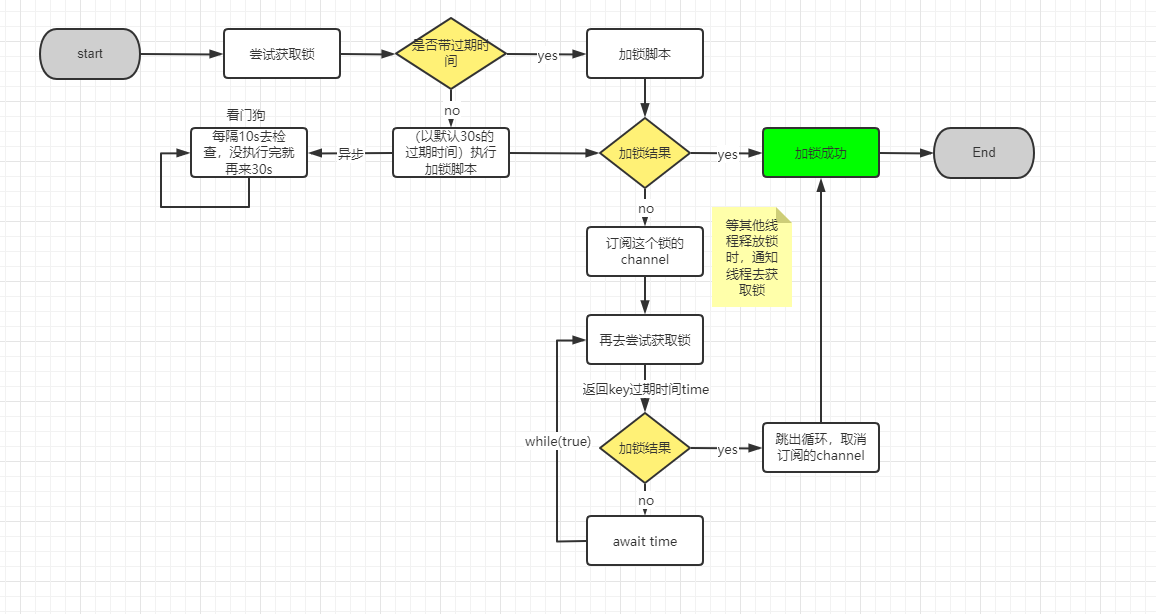Redis分布式锁,看完不懂你打我
简易的redis分布式锁
加锁:
set key my_random_value NX PX 30000
这个命令比setnx好,因为可以同时设置过期时间。不设置过期时间,应用挂了,解不了锁,就一直锁住了。
解锁:
if redis.call("get",KEYS[1])==ARGV[1] then
return redis.call("del",KEYS[1])
else
return 0
end
先比较一下值,相等才删除。防止其他线程把锁给解了。
以上方案在一般的场景就够用了,但还存在一些小问题:
- 如果设置过期时间3秒,但是业务执行需要4秒怎么办?
解决方案:参照redisson的看门狗,可以后台起一个线程去看看业务线程执行完了没有,如果没有就延长过期时间。
- redis是单点的,如果宕机了,那么整个系统就会崩溃。如果是主从结构,那么master宕机了,存储的key还没同步到slave,此时slave升级为新的master,客户端2从新的master上就能拿到同一个资源的锁。这样客户端1和客户端2都拿到锁,就不安全了。
解决方案:RedLock算法。简单说就是N个(通常是5)独立的redis节点同时执行SETNX,如果大多数成功了,就拿到了锁。这样就允许少数节点不可用。
那我们看看工业级别是怎么实现redis分布式锁的呢?
Redission实现的redis分布式锁
加锁流程:
解锁流程:

Redission加锁使用的是redis的hash结构。
- key :要锁的资源名称
- filed :uuid+":"+线程id
- value : 数值型,可以实现可重入锁
源码里面用到了netty里面Promise的一些api,我列出来帮助理解:
// 异步操作完成且正常终止
boolean isSuccess();
// 异步操作是否可以取消
boolean isCancellable();
// 异步操作失败的原因
Throwable cause();
// 添加一个监听者,异步操作完成时回调,类比javascript的回调函数
Future<V> addListener(GenericFutureListener<? extends Future<? super V>> listener);
Future<V> removeListener(GenericFutureListener<? extends Future<? super V>> listener);
// 阻塞直到异步操作完成
Future<V> await() throws InterruptedException;
// 同上,但异步操作失败时抛出异常
Future<V> sync() throws InterruptedException;
// 非阻塞地返回异步结果,如果尚未完成返回null
V getNow();
源码分析:
加锁:
public RLock getLock(String name) {
return new RedissonLock(connectionManager.getCommandExecutor(), name);
}
public RedissonLock(CommandAsyncExecutor commandExecutor, String name) {
super(commandExecutor, name);
//命令执行器
this.commandExecutor = commandExecutor;
//uuid
this.id = commandExecutor.getConnectionManager().getId();
//超时时间,默认30s
this.internalLockLeaseTime = commandExecutor.getConnectionManager().getCfg().getLockWatchdogTimeout();
this.entryName = id + ":" + name;
}
public void lockInterruptibly(long leaseTime, TimeUnit unit) throws InterruptedException {
//获取线程id
long threadId = Thread.currentThread().getId();
//尝试获取锁
Long ttl = tryAcquire(leaseTime, unit, threadId);
// lock acquired
//ttl为空则代表加锁成功
if (ttl == null) {
return;
}
//如果获取锁失败,则订阅到对应这个锁的channel,等其他线程释放锁时,通知线程去获取锁
RFuture<RedissonLockEntry> future = subscribe(threadId);
commandExecutor.syncSubscription(future);
try {
while (true) {
//再次尝试获取锁
ttl = tryAcquire(leaseTime, unit, threadId);
// lock acquired
if (ttl == null) {
break;
}
// waiting for message
//ttl大于0,则等待ttl时间后继续尝试获取锁
if (ttl >= 0) {
getEntry(threadId).getLatch().tryAcquire(ttl, TimeUnit.MILLISECONDS);
} else {
getEntry(threadId).getLatch().acquire();
}
}
} finally {
//取消对channel的订阅
unsubscribe(future, threadId);
}
// get(lockAsync(leaseTime, unit));
}
再来看看里面的尝试获取锁的代码:
private Long tryAcquire(long leaseTime, TimeUnit unit, long threadId) {
return get(tryAcquireAsync(leaseTime, unit, threadId));
}
private <T> RFuture<Long> tryAcquireAsync(long leaseTime, TimeUnit unit, final long threadId) {
if (leaseTime != -1) {
//如果带有过期时间,则按照普通方式获取锁
return tryLockInnerAsync(leaseTime, unit, threadId, RedisCommands.EVAL_LONG);
}
//先按照30秒的过期时间来执行获取锁的方法
RFuture<Long> ttlRemainingFuture = tryLockInnerAsync(commandExecutor.getConnectionManager().getCfg().getLockWatchdogTimeout(), TimeUnit.MILLISECONDS, threadId, RedisCommands.EVAL_LONG);
//异步执行回调监听
ttlRemainingFuture.addListener(new FutureListener<Long>() {
@Override
//如果还持有这个锁,则开启定时任务不断刷新该锁的过期时间
public void operationComplete(Future<Long> future) throws Exception {
//没有成功执行完成
if (!future.isSuccess()) {
return;
}
//非阻塞地返回异步结果,如果尚未完成返回null
Long ttlRemaining = future.getNow();
// lock acquired
if (ttlRemaining == null) {
scheduleExpirationRenewal(threadId);
}
}
});
return ttlRemainingFuture;
}
看门狗逻辑:
使用的是Netty的Timeout延迟任务做的。
- 比如锁过期 30 秒, 每过 1/3 时间也就是 10 秒会检查锁是否存在, 存在则更新锁的超时时间
加锁脚本
<T> RFuture<T> tryLockInnerAsync(long leaseTime, TimeUnit unit, long threadId, RedisStrictCommand<T> command) {
internalLockLeaseTime = unit.toMillis(leaseTime);
return commandExecutor.evalWriteAsync(getName(), LongCodec.INSTANCE, command,
//如果锁不存在,则通过hset设置它的值,并设置过期时间
"if (redis.call('exists', KEYS[1]) == 0) then " +
"redis.call('hset', KEYS[1], ARGV[2], 1); " +
"redis.call('pexpire', KEYS[1], ARGV[1]); " +
"return nil; " +
"end; " +
//如果锁已存在,并且锁的是当前线程,则通过hincrby给数值递增1,并重新设置过期时间
"if (redis.call('hexists', KEYS[1], ARGV[2]) == 1) then " +
"redis.call('hincrby', KEYS[1], ARGV[2], 1); " +
"redis.call('pexpire', KEYS[1], ARGV[1]); " +
"return nil; " +
"end; " +
//如果锁已存在,但并非本线程,则返回过期时间
"return redis.call('pttl', KEYS[1]);",
Collections.<Object>singletonList(getName()), internalLockLeaseTime, getLockName(threadId));
}
解锁:
public RFuture<Void> unlockAsync(final long threadId) {
final RPromise<Void> result = new RedissonPromise<Void>();
//底层解锁方法
RFuture<Boolean> future = unlockInnerAsync(threadId);
future.addListener(new FutureListener<Boolean>() {
@Override
public void operationComplete(Future<Boolean> future) throws Exception {
if (!future.isSuccess()) {
cancelExpirationRenewal(threadId);
result.tryFailure(future.cause());
return;
}
Boolean opStatus = future.getNow();
//如果返回空,则证明解锁的线程和当前锁不是同一个线程,抛出异常
if (opStatus == null) {
IllegalMonitorStateException cause = new IllegalMonitorStateException("attempt to unlock lock, not locked by current thread by node id: "
+ id + " thread-id: " + threadId);
result.tryFailure(cause);
return;
}
if (opStatus) {
cancelExpirationRenewal(null);
}
result.trySuccess(null);
}
});
return result;
}
解锁脚本:
protected RFuture<Boolean> unlockInnerAsync(long threadId) {
return commandExecutor.evalWriteAsync(getName(), LongCodec.INSTANCE, RedisCommands.EVAL_BOOLEAN,
"if (redis.call('exists', KEYS[1]) == 0) then " +
"redis.call('publish', KEYS[2], ARGV[1]); " +
"return 1; " +
"end;" +
//如果释放锁的线程和已存在锁的线程不是同一个线程,返回null
"if (redis.call('hexists', KEYS[1], ARGV[3]) == 0) then " +
"return nil;" +
"end; " +
//通过hincrby递减1的方式,释放一次锁
"local counter = redis.call('hincrby', KEYS[1], ARGV[3], -1); " +
//若剩余次数大于0 ,则刷新过期时间
"if (counter > 0) then " +
"redis.call('pexpire', KEYS[1], ARGV[2]); " +
"return 0; " +
"else " +
//否则证明锁已经释放,删除key并发布锁释放的消息
"redis.call('del', KEYS[1]); " +
"redis.call('publish', KEYS[2], ARGV[1]); " +
"return 1; "+
"end; " +
"return nil;",
Arrays.<Object>asList(getName(), getChannelName()), LockPubSub.unlockMessage, internalLockLeaseTime, getLockName(threadId));
}
书山有路勤为径,学海无涯苦作舟
分类: 技术点